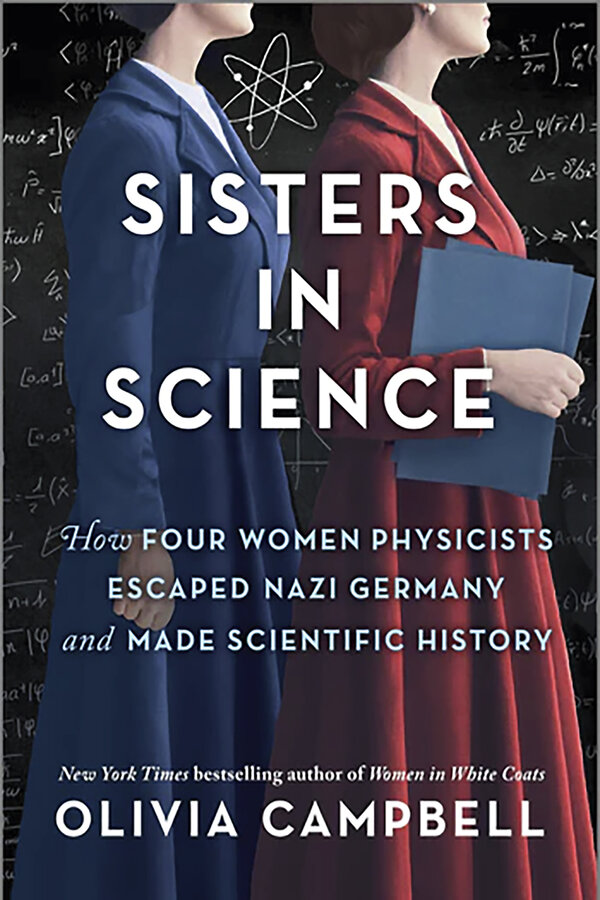How four women physicists escaped the Nazis, but lost their life’s work
Loading...
The accomplishments of German physicists like Albert Einstein, Max Planck, and Gustav Hertz are well known. In “Sisters in Science: How Four Women Physicists Escaped Nazi Germany and Made Scientific History,” Olivia Campbell notes that physics experienced a golden age in the early 20th century, “with Germany its beating heart.”
But as its title suggests, Campbell’s book centers around less-celebrated figures from that consequential period. Lise Meitner, Hedwig Kohn, Hertha Sponer, and Hildegard Stücklen were all trailblazers in the field, part of an elite group of women who were certified to teach physics at the university level in Germany before World War II. Across all disciplines, there were only 56 women in the country who were university lecturers or professors when Adolf Hitler came to power in 1933. Most were fired from their hard-won positions as a result of Nazi policies.
While women’s rights had advanced under the Weimar Republic, Nazi ideology claimed women’s place was in the home as wives and mothers. Jewish women, of course, were targeted for their religious identities, but non-Jewish women could be dismissed simply for being female, especially if they were seen as political opponents of Nazism or as sympathetic to their Jewish colleagues.
All four of Campbell’s protagonists lost their jobs and struggled to find positions in physics outside Germany. Campbell, a journalist and the author of 2021’s “Women in White Coats,” notes that as women, they’d had a more difficult time than men advancing in the field and receiving proper credit for their contributions. This in turn made it harder for them to secure desperately needed job offers abroad.
The narrative’s two Jewish women, Meitner and Kohn, were in particular danger. Meitner, the best known of the four, helped discover nuclear fission. She was born in Austria but moved to Germany after completing her doctorate in 1906 because, as she was a woman in Austria, her degree would only qualify her to teach high school. She became a professor at the University of Berlin and Germany’s first female full professor of physics. She also became the head of the physics department of the Kaiser Wilhelm Institute for Chemistry (KWI-C). She was fired from the university when Hitler became chancellor but was able to remain in her position at the research institute at first.
As conditions for Jewish people became more dire, she realized that she had to flee Germany. (“Possibilities narrowing,” she wrote ominously in her diary in April 1938, shortly after Germany annexed Austria, invalidating her Austrian passport.) With the help of friends and colleagues, she managed a nerve-racking escape to Sweden, leaving most of her belongings behind.
Campbell makes clear how devastating the move was for Meitner. Speaking of the KWI-C, Meitner wrote to a friend, “I built it from its very first little stone; it was ... my life’s work, and it seemed so terribly hard to separate myself from it.” She also poignantly described the disorientation of her life in exile, writing, “One [dares] not look back. One cannot look forward.” Her colleague Otto Hahn won a Nobel Prize in 1944 for the discovery of nuclear fission. Campbell observes that Meitner was forced to “watch her life’s work carry on without her.”
Kohn, who earned her doctorate in physics in 1913, had an even closer call. She lost her job teaching physics at the University of Breslau in 1933, but she scraped by with part-time work until 1938, when the Nazis banned Jewish people from all employment. Friends and colleagues scrambled to find her a research position at the University of Aberdeen in Scotland.
Her British visa came through in August 1939 but was revoked two weeks later, as she was preparing to leave Breslau, when the United Kingdom declared war on Germany.
Campbell quotes from the dozens of letters mailed throughout the United States and Europe by those working frantically to help Kohn escape before the June 1940 date of her scheduled deportation to Poland.
The author highlights the important role of relief organizations such as the American Association of University Women in the story. Individuals including atomic physicist Rudolf Ladenburg and Nobel-winning physicist James Franck – both of whom, like Einstein, left Germany for the United States in the early 1930s – also played pivotal parts. (Campbell reports that a dozen German Nobel laureate scientists emigrated to the U.S. between 1930 and 1941.)
Franck had supported female scientists when he was in Germany, and once in America he devoted himself to finding positions for several who lost their jobs – and whose lives were at risk – after the Nazis came to power. He and Sponer, his onetime protégé, eventually married.
While Campbell’s subject matter is compelling, her writing is often workmanlike. In addition, it doesn’t always measure up to the gravity of her topic.
Referencing the Nazi annexation of Austria, she writes, “The Nazis took their show on the road.” Of women’s expulsion from elite professions, she states, “Women doctors, judges, and lawyers – Hitler wasn’t having it.”
Still, she’s created an engaging account of an overlooked topic. “Sisters in Science” devotes a chapter to several women scientists who weren’t as fortunate as Meitner, Kohn, Sponer, and Stücklen, and who died at the hands of the Nazis. “So much brilliance wasted,” Campbell aptly observes.







